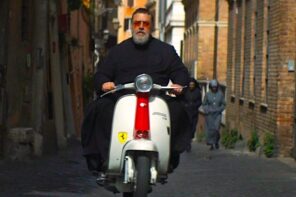It is commonly understood that this Pope, who served as theological adviser to the previous Pope, has continued and even intensified the anti-Modern papal agenda of the past thirty years. Such anti-Modernism has been a prominent feature of the global religious landscape since 1979: the year Jerry Falwell founded the “Moral Majority”; the year the Ayatollah Khomeini returned to Iran; and the year John Paul II became the first non-Italian pope since the mid-1500s.
Bruce Lawrence already performed an important comparative analysis of such religious anti-Modernism in 1989, in an important book called Defenders of God.
In the specifically Catholic context, both John Paul II and Benedict XVI seem to be running from, and actually running against, the progressive spirit of the Second Vatican Council of the early 1960s, and its new “spirit of openness to the modern world.” But what these men understand as “Modern” is not entirely clear.
Perhaps a better way to say this is that the target keeps shifting in papal polemics about Modernity. Whereas Modernism was associated with the natural sciences and Liberal theology in the early 20th century, the twinned ideologies of feminism and secularism came under increasing fire in the 1970s. These days, the culture of the Modern (and it is important to recall that this name derives from the Latin hodiernus, a word referring to the “contemporary,” or “today”) is roundly lambasted as “a culture of death.”
It would be a grave mistake to underestimate this Pope’s intelligence, or the sophistication of this critique. If anything, the contemporary world seems hell-bent on giving the papacy ammunition. The capitalist system seems as morally bankrupt as its financial institutions currently are. Wars are declared unilaterally, despite the ineffectual condemnation of the world community (and the Vatican), then drag on endlessly without respite or a clear sense of the purpose.
The Terror You Shall Always Have With You…
Catholic anti-Modernism, at its best, seems grounded in a poignant sense of historical irony. The very materialism of the contemporary Western world—its fixation on markets and technology and development, as well as its ever-expanding wars in the name of security—ironically undoes the material world.
Advanced industry poisons the planet. Corrupt and dishonest Wall Streeters poison the global financial system. A war against terror actually breeds more terror, and creates a radicalized geopolitical zone larger now than ever before.
The Modern West’s allegedly life-promoting institutions, precisely because of their excessive materialism, actually foster death. This is not a superficial analysis or critique, and there is much in it that a progressive secularist could agree with.
Feminism and sexual ethics frame the issues where the two sides necessarily part company.
It is important to recall that Catholic anti-Modernism is not new; it too has a history. In fact, Catholic anti-Modernism is celebrating an ironic centennial. As Claus Arnold documents in his recent analysis of newly-released documents in the Vatican Secret Archives, the Church came only slowly to its current theological anti-Modernism (his essay, “Antimodernismo e magistero Romano: la redazione della Pascendi,” Rivista di storia del Cristianesimo 5 [2009], 345-364, offers an analysis of the discussions prior to release of the Vatican’s two primary anti-Modernist documents: the decree Lamentabili sane exitu and the encyclical Pascendi).
So much, then, for the history of anti-Modern Catholic theology. But there is far more to the Church’s new anti-Modernism than theology. What I would like to propose is an alternative account of the contemporary situation and the Vatican’s pragmatic, rather than theological, reaction to it.
If one were to consult a map of the world and to look at it from the Vatican’s perspective, then an interesting Europe, with the exception of Italy, is lost. It is not only secular; its populations are increasingly agnostic and free-thinking. Italy remains Catholic for cultural and historical, rather than necessarily theological, reasons.
North America also seems lost. American Catholics in increasingly large numbers part with the Vatican over precisely the issues one would expect: feminism and sexual ethics. Birth control and abortion are not only “litmus tests” for US Supreme Court justices; they provide the banners both progressive and anti-Modern Catholics carry into cultural battle today. It is scarcely imaginable how, given the current impasse, North American Catholics will not re-define their relationship to Roman authority in the relatively near future.
So, if Euro-America is a lost Vatican cause, then where is the Church growing? Where is its future? The answer seems relatively clear. The Church is growing in South America, in sub-Saharan Africa, and is even making significant inroads in the Far East. And what these emerging Catholic populations want is a culturally conservative theology (recall the uproar in these same regions when the openly gay Anglican bishop, Gene Robinson, was confirmed).
The code word for most of that uproar is “anti-Modern.”
So the irony of Catholic anti-Modernism multiplies, morphs, turns back on itself. The logic of Catholic anti-Modernism, as it were, is capitalist to the core. The Vatican looks at the world map and analyzes new growth markets. When one source of material resources dries up, the empire marches determinedly on. From this perspective, China represents a relatively virgin market of some one billion souls. Such reasoning seems far more pragmatic than theological.
Whether it is descriptively true only time will tell. But I for one have my doubts.




